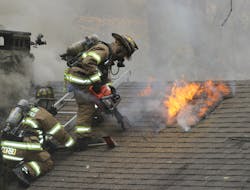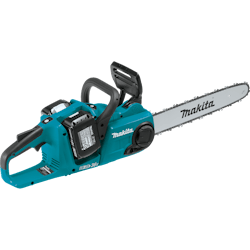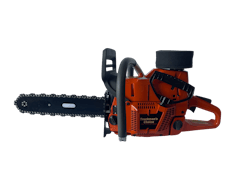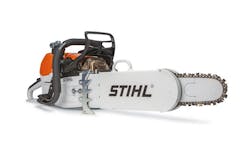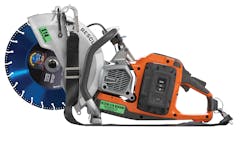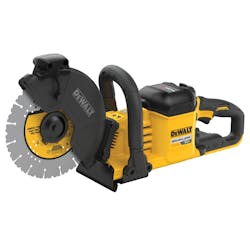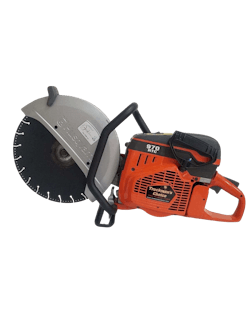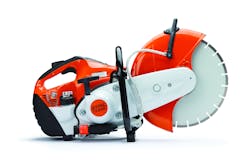It’s a new era for fireground saws. The progress that’s been achieved in the technology of battery-powered models justifies their consideration instead of—or, at minimum, along with—the gasoline-powered variety. The same can be said for certain commercial chainsaws and circular saws and fire service-specific units.
Commercial vs. fire-specific
Historically, the fire service has used saws that are engineered with the firefighter in mind. A larger handle (to accommodate a gloved hand), carbide-tipped chains, depth gauges and bars that have cobalt inserts have been standard for years.
What about the commercial saws that are sold in big-box stores and online? Can those models be counted on to do what their fire service-specific counterparts do?
Julio Ramos, who is a fire lieutenant in Florida, believes that commercial units can be as good as their rescue counterparts, although it depends on the mission.
Ramos also is the owner/operator of Fireground & Special Operations Concepts, which provides training that’s specific to saw manipulation and truck work. He breaks down the choice of fire service-specific versus commercial-grade for Firehouse Magazine in this way: If fire departments purchase power tools, including chainsaws (aka ventilation saws) and circular saws (aka rotary saws), from the commercial space, a complete understanding of the tool’s functionality and application is imperative. For example, “A lot of people will go to the hardware store and pick up the incorrect saw and put the wrong fire service-specific blade on it,” Ramos explains. “Match the blade with the powerhead with the mission,” he urges.
Ramos contends that when a fire company is tasked with vertical ventilation for the roof on a residential structure, a 70-cc gasoline-powered chainsaw is more than enough.
The vast difference in price point between a fire service-specific model and a commercial unit often boils down to the labor that’s required to build a fire service-specific saw off of the powerhead and motor platform. That said, if a department wishes to convert a commercial saw to a fire rescue saw, it can be done.
Understand the concept and anyone can do it, Ramos says. “The information is out there.”
Wayne Hart of Makita USA says in no uncertain terms that his company’s commercial battery-powered models are suited to fire service needs. “That could be metal-decking, or it could be a car door,” Hart tells Firehouse Magazine. In fact, the manufacturer recently released a 14-inch circular saw, which Hart says is one of the first of its kind, given that numerous battery-powered circular saw blades are no larger than nine inches.
How does Makita measure up on the fireground? Seemingly well, if the Austin, TX, Fire Department’s (AFD) $75,000 purchase of a full complement of Makita battery-powered products serves as any indication. The department spent the better part of two years researching and testing various makes of power tools. That led to the AFD outfitting all of its 13 aerial companies, four rescue units and a few special operations rigs with the Makita battery-powered lineup.
AFD Battalion Chief Lance Zenkner, who works in the division of operations support, and Firefighter Philip Wassel, were the driving forces behind the Makita project.
Zenkner says the department tested the new 14-inch circular saw and presented feedback to the company, including a recommendation that the size of the start button be enlarged to accommodate a firefighter’s gloved hand.
“Overall, the saw was really good,” Zenkner notes. “It performed well.”
Concerning a meticulous evaluation of circular saws and other power tools, Wassel says, “Going through that super-thorough vetting process really will bring clarity to the myriad of brands and products out there. Be slow and methodical about it.”
Tom Reddy of TEAM Equipment shares that his company was struck by a fundamental problem that can emerge from a lack of torque from the battery/motor combination, which can produce cutting capability that falls short of what’s needed of the fire service. Reddy claims that the new K12FD-E14 14-inch Rescue Saw that’s built on Husqvarna’s new K1 Pace battery and motor technology “changed the K12 rescue saw forever.”
According to the manufacturer, one battery will last the approximate equivalent of one tank of gasoline with light cutting, although Reddy adds, “Most demonstrations have been cutting heavy material, providing heavy strain on the battery and motor, depleting the battery faster than an equivalent tank of gas. Still, one battery has proven plenty for what most fire departments will need on a call.”
Trevor DeCamp of Stanley Black & Decker has seen his company’s DeWalt DCS690X2 9-inch battery-powered commercial cut-off saw gain momentum in the fire service for its ease of use via the virtual elimination of maintenance because of an all-metal drivetrain.
Fueling interest
Ray Smeriglio, who is president of Eastern Fire Equipment Services, which produces the Truckman’s Choice line of gasoline-powered chainsaws and circular saws, says, “For us, it is all about the modifications.”
The company starts with a professional-grade Husqvarna engine and will “tune it up and build out” a chainsaw that cuts built-up commercial roof deck.
Modifications, Smeriglio contends, are the reason why his saws cost more than those that are found on a hardware store shelf.
Tempest Technology, which makes Ventmaster Saws, recently outfitted the San Francisco Fire Department (SFFD) with 112 gasoline-powered chainsaws and power cutters, which amounted to a purchase of $300,000 in product. Bill Allen, who is a product manager with the manufacturer, says that the chainsaws tackle a variety of roofing material, residential siding, roll-up doors and downed trees.
SFFD Lt. Vince Wong works in the department’s bureau of equipment, where he services small engines and tools. Wong tells Firehouse Magazine that the SFFD switched from Cutter’s Edge (now Truckman’s choice) to Ventmaster six months ago.
However, the SFFD will be looking to outfit its Ventmaster chainsaws with the Truckman’s Choice bullet chains. The purpose of this move is to minimize the frequency of chain breakage.
The durability of Tempest equipment ties directly to the Husqvarna powerhead that’s used and its focus on the commercial environment. “Commercial, fire departments, logging, and lawn and garden: All of that technology is spread across all of those areas,” Allen claims.
Two STIHL gasoline-powered products are designed “exclusively for specially trained fire, rescue and emergency personnel,” Product Manager John Allen says.
The MS 462 R C-M Rescue chainsaw includes STIHL’s M-Tronic intelligent engine management system. At its core is an automatic electronically adjusted carburetor. It and other systems that are like it remove the need for firefighters to adjust the carburetor in times of need on the fireground and elsewhere, such as in smoky conditions and changes in altitude, temperature and humidity. This capability can be particularly helpful to younger members, who might not be in tune with the finer details of a chainsaw, as their more veteran counterparts might be.
The STIHL gasoline-powered TS 500i Cutquik cut-off machine includes what the company believes is the handheld outdoor power equipment industry’s first electronically controlled fuel-injection system. It increases power by 17 percent while only increasing weight by 6 percent, compared with the company’s previous technology.
The final cut
At the end of the day, we believe that there is no reason why departments must default to fire-specific chainsaws and circular saws. That said, those who will make the choice will be best served by emulating their fellow members in Austin and San Francisco by putting in the time and effort to conduct a thorough evaluation.
Hot Picks: Chainsaws/Ventilation Saws and Circular Saws/Rotary Saws
Firehouse Magazine’s “Hot Picks” chainsaws/ventilation saws and circular saws/rotary saws are listed with their manufacturer’s suggested retail price (MSRP). “Hot Picks” models include commercial-grade units that can be purchased at a brick-and-mortar retailer or a retail website. Often, the price that you will find for such models will be different than the MSRP, including, perhaps, 1 percent–5 percent less.
The MSRP for fire-specific models of chainsaws and circular saws can be substantially more than their commercial-grade counterparts. Manufacturers of fire-specific models tell us that the difference in MSRPs results from the addition of components that typically aren’t found on commercial-grade units and the labor that’s involved in incorporating those additional components to the base configuration of the product.
Although the warranties for our “Hot Picks” vary in length of coverage, we came away confident that the coverage of the various warranties is comparable when it comes to the manufacturer standing behind the quality of its product and its support should something go wrong with the product. A limited warranty is constrained to specified parts, certain types of defects or other conditions. None of the models that we considered come with a full warranty, which by federal law requires a manufacturer to repair or replace a product without any caveats.
fps = feet per second; NA = not available
CHAINSAWS/VENTILATION SAWS
BATTERY-POWERED
Makita XCU04PT1 36V LXTThe combination of an adjustable automatic chain lubrication function and the interoperability of the battery with 300 other LXT power tools and products from the manufacturer sets the XCU04PT1 36V LXT apart from competitive commercial-grade battery-powered chainsaws. The 3-year limited warranty that’s provided with this chainsaw wasn’t exceeded by any of the models that we considered for recommendation. For those who already use LXT products and have batteries, a package that omits the batteries and charger has an MSRP of $329.
· MSRP: $379
· Battery: 36 volts (two 18v batteries)
· Maximum run time: 200 cuts in 4x4 cedar
· Bar length: 16 in.
· Chain adjustment: Tool-less
· Maximum chain speed: 65.7 fps
· Weight: 11.1 lbs.
· Warranty: 3-yr. limited
GASOLINE-POWERED
Tempest Ventmaster 572-HD
· MSRP: $3,259
· Engine: 70.6 cc
· Bar length: 16 in.
· Chain adjustment: Tool-less
· Maximum chain speed: 96.0 fps
· Weight: 22.9 lbs. (dry)
· Warranty: 1-yr. limited
Truckman’s Choice 372XP-TC Fire Rescue
· MSRP: $2,133
· Engine: 71.0 cc
· Bar length: 16 in.
· Chain adjustment: Tooled
· Maximum chain speed: 106–121 fps, depending on sprocket size
· Weight: 15.7 lbs. (dry, powerhead only)
· Warranty: 2-yr. limited
STIHL MS 462 R C-M Rescue
· MSRP: $1,499
· Engine: 72.2 cc
· Bar length: 20 in.
· Chain adjustment: Tooled
· Maximum chain speed: NA
· Weight: 14.3 lbs. (dry, power head only)
· Warranty: 90-day limited
CIRCULAR SAWS/ROTARY SAWS
BATTERY-POWERED
TEAM K12FD-E14 Rescue
· MSRP: $3,299 (includes blade, two batteries & charger)
· Battery: 94 volts
· Motor: Brushless
· Maximum run time: NA
· Blade diameter: 14 in.
· Maximum cutting depth: 5.7 in.
· Maximum blade speed: 3,400 rpm
· Weight: 23.0 lbs.
· Warranty: 1-yr. limited
DEWALT DCS690X2
· MSRP: $899
· Battery: 60 volts
· Motor: Brushless
· Maximum run time: 96 cuts in #5 rebar
· Blade diameter: 9.0 in.
· Maximum cutting depth: 3.25 in.
· Maximum blade speed: 6,500 rpm
· Weight: 10.9 lbs. (no blade or battery)
· Warranty: 3-yr. limited
GASOLINE-POWERED
Truckman’s Choice 970RTC14A Rescue Saw
· MSRP: $2,552
· Engine: 104 cc (approx.)
· Blade diameter: 14-in.
· Maximum cutting depth: 5 in
· Maximum spindle speed: NA
· Weight: 24.3 lbs. (no distinction between dry/wet)
· Warranty: 2-yr. limited
STIHL TS 500i Cutquik
· MSRP: $1,599 (minus wheel)
· Engine: 72.2 cc
· Blade diameter: 14 in.
· Maximum cutting depth: 4.9 in.
· Maximum spindle speed: 5,350 rpm
· Weight: 22.5 lbs. (dry w/o wheel)
· Warranty: 90-day limited
About the Author

Kristen Wade
Kristen Wade is a battalion chief and EMS program manager with the Sugar Grove, IL, Fire Protection District and is in charge of an engine and ambulance company. She has nearly two decades of experience in the fire service and 15 years of experience as an Illinois licensed paramedic. Wade served as an instructor for the Illinois Fire Service Institute’s fire officer program. She is certified by Illinois Firefighter Peer Support. The organization focuses on the mental health and wellness of EMS and fire personnel. She obtained a bachelor’s degree in English communications from Fort Lewis College.
